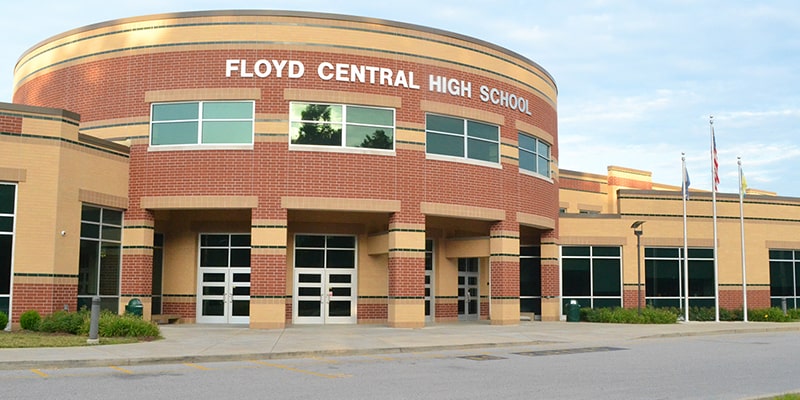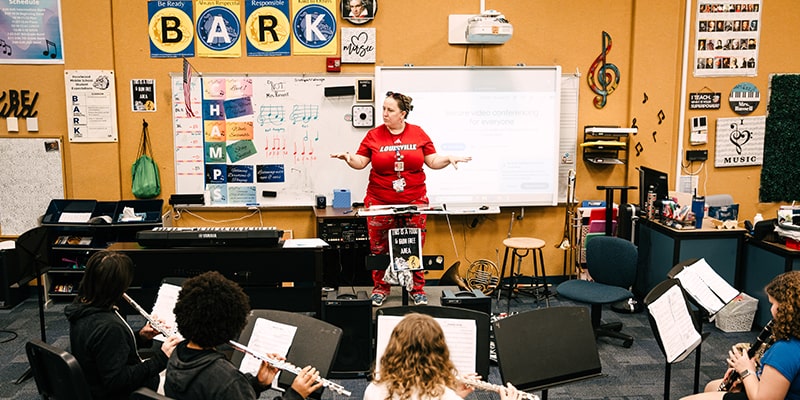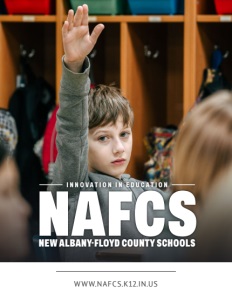Innovation in Education
A Midwest school district demonstrates how strategic leadership, innovative programs, and financial acumen create educational excellence for all pathways.
When New Albany-Floyd County Schools (NAFCS) reshaped their mission over the last year and a half, they distilled it to a powerful yet simple concept: student-centered and future-focused. For Dr. Travis Madison, superintendent of this district comprising 16 campuses, this mission serves as the filter through which every decision must pass.
“We want to make sure that the decisions we make and take to our board of trustees are always centered around what’s best for our students,” says Dr. Madison. “They’re the reason we’re here. We’ve got a lot of adults we employ and many different programs, but everything we do must be in the best interest of our students and the various needs they bring to the table.”
This comprehensive approach spans from food service to curriculum development, mental health resources to special education services. The district aims to meet all these needs so students can learn in a safe, conducive environment. The “future-focused” component acknowledges education’s evolving nature and prepares students not just for the next grade level but for life beyond graduation.
“Our job is to prepare our kids for what lies ahead,” Dr. Madison explains. “If you have a kindergarten student looking at first grade, we’re putting together unbelievable opportunities each day to prepare them for what’s next. Ultimately, we want them to leave us as graduates ready to achieve whatever they want in life.” This forward-thinking mindset recognizes that the future constantly changes, requiring the district to evolve accordingly.
Post-COVID Resilience: The Four Cs Framework
As school districts nationwide continue to grapple with the aftermath of the pandemic, NAFCS is confronting these challenges head-on. “There was a mind shift that came out of the pandemic that we’re not only feeling in education but in the private sector as well. The pendulum always swings both ways, but I think we’re coming back from that,” Dr. Madison notes. His response was to create the “Four Cs” framework that guides the district’s post-pandemic approach.
Connection stands as the framework’s foundation, addressing what many educators identify as the pandemic’s most significant casualty. “That’s something during the pandemic I felt we lost; the opportunity to connect. Connection is more than just being on a screen. It’s developing strong relationships between students and teachers, and enabling our teachers to work together as teams,” says Dr. Madison. This emphasis on human connection aligns with research showing that strong teacher-student relationships significantly impact academic achievement, particularly following periods of educational disruption.
The second C, Contribution, focuses on valuing every team member’s role. “We want everybody to understand that they’re a huge piece of the puzzle, from facilities’ folks to food service, transportation to teachers. We all have a piece in that child’s success, and no one is more important than the other,” Dr. Madison explains.
Challenge, the third component, pushes back against the tendency to use the pandemic as justification for lowered expectations. “We can’t lose sight that our kids need us to challenge them. We need to raise expectations rather than maintain the status quo,” says Dr. Madison. He specifically highlights attendance issues as an exacerbated post-COVID problem affecting both students and staff. The final C, Celebration, emphasizes recognizing achievements and honoring collective successes while creating the positive reinforcement essential for rebuilding educational momentum.
Building and Retaining a Quality Educational Workforce
Teacher recruitment and retention remain critical challenges for American school districts, with the National Education Association reporting a nationwide shortage of approximately 300,000 teachers and staff. NAFCS has implemented strategic initiatives to address these workforce issues, starting with competitive compensation.
“My office and the chief financial officer’s office have worked diligently to raise our minimum pay,” says Jeanine Corson, Chief Human Resources Officer. “Our teacher pay is slightly over $50,000 a year, and we continue to monitor to ensure we remain competitive in the marketplace. When I arrived seven years ago, our starting pay in many positions was $12 an hour. Now most positions are well above $15 in starting pay.”
Beyond salary increases, NAFCS recognizes the changing nature of educational careers. Research indicates that teachers who remain in the profession beyond seven years are likely to stay long-term, while those who leave earlier rarely return to teaching. This pattern has been exacerbated by a significant decline in education program enrollment.

“About five years ago, there was a 30% decrease in people enrolling in education programs,” Corson explains. “So, what do we do? We’ve increased pay, promoted certification programs to our staff, and developed university partnerships for student teaching placements.”
These university collaborations have yielded impressive results. “In my first year, we had maybe five student teachers. Now we’re up to 45 people a year. That’s just connecting with universities and asking them to send their student teachers to us,” says Corson.
Strategic Financial Management and Infrastructure Planning
Educational infrastructure in the United States faces significant challenges, and NAFCS has taken a methodical approach to address these needs through comprehensive planning and strategic financial management.

“The corporation started an infrastructure study with Schmidt and Associates to find out the physical plant needs of the corporation,” explains Dr. Joseph Voelker, Chief Operations Officer. “We’ve found needs at all our properties to the tune of almost $400 million. We’re not going to be able to do all that, but we’re trying to prioritize those dollars based on high, medium, and low needs to be addressed in the next five to seven years at each building.”
This systematic assessment aligns with best practices in educational facility management, which emphasize data-driven decision-making for capital improvements. Dr. Madison points out that despite the substantial price tag, the district has positioned itself advantageously through innovative financing approaches.

“We’ve been very progressive utilizing different means and alternate ways of finding revenue to tackle these issues,” Dr. Madison says. “We’ve been using bonds, which is a unique way of approaching some of these bigger ticket items but then splicing them off at different times within different programming methods.”
Chris Street, Chief Financial Officer, attributes this financial stability to decades of careful planning. “Our board and facilities team have invested in capital, ensuring our buildings are in strong positions of maintenance. When we get toward the end of a life cycle, we’re replacing HVACs, boilers, chillers, and roofs so we can reduce year-to-year maintenance costs,” Street explains.
Preparing Students for All Paths
“As a district in the state, I don’t feel there are many districts that position kids better than ours,” Dr. Madison asserts. “At both high schools, we have tremendous partnerships with local universities providing dual credit opportunities that give students a head start on college without significant out-of-pocket costs.”
These articulation agreements with higher education institutions reflect a growing national trend, with research showing students who earn college credit in high school are more likely to enroll in and complete postsecondary education. However, NAFCS recognizes that a four-year university path isn’t appropriate for all students.
“Our state is shifting significantly with pathways,” says Dr. Madison. “We have an unbelievable career center in Prosser that falls under our umbrella. We own and operate it, but we’re in a consortium with 13 other school districts and 23 other high schools.”
As the largest career center in Indiana, Prosser offers 27-30 different programs that provide juniors and seniors with hands-on workforce preparation. “We have aviation, construction, building trades, and we’re adding plumbing and pipe fitting,” Dr. Madison explains. “We’re trying to find those high-need areas and setting up programs at the career center.”
The demand for these career pathways exceeds capacity, indicating their value to students and the broader economy. “We turn away students, which is probably the most frustrating thing. We’re in the process of looking to expand those opportunities,” notes Dr. Madison.
Arts, Athletics, and Well-Rounded Education
NAFCS has developed a comprehensive approach to extracurriculars that extends far beyond the traditional emphasis on core academics. Educational research consistently demonstrates that participation in extracurricular activities correlates with higher academic achievement, improved attendance, and decreased dropout rates.
“When I was a teacher in the district, I saw that performing arts, sports, and clubs gave kids an opportunity to get involved and develop a stronger connection to school,” says Street, who brings this philosophy to his role as CFO. “I looked at almost all those programs as co-curricular rather than extracurricular and part of a well-rounded education. Kids who are involved tend to be better students and more productive in school.”
This perspective aligns with contemporary educational research suggesting that arts education and athletic participation develop crucial non-cognitive skills including perseverance, teamwork, and creative problem-solving. The district deliberately provides diverse opportunities across all educational levels.
“We offer a wide array of things for kids to get involved in,” Street explains. “Some places, if you’re not into sports or certain activities, you run out of options. Here we have hundreds of options in our schools. I place a lot of value on having a strong core curriculum as well as a wide array of performing arts, electives, and sports programs.”
Dr. Voelker highlights the exceptional quality of these programs, many of which have received state and national recognition. “It would be hard to find a district with such a strong band, choir, orchestra, and theater programs as our school district at both New Albany and Floyd Central High Schools,” he says. “Floyd Central won the state orchestra competition in 2023. The Floyd Central Choir won the Mixed Choir championship in 2015.” In addition to those State Honors, New Albany High School’s Boys Basketball has had success with a State Championship in 2016. Both New Albany High School and Floyd Central High School share a radio station as well as offering state recognized radio and TV multimedia classes.

The district’s offerings include athletics and other competitive activities. “Many places say, ‘we’re a football school’ or ‘we’re a basketball school,’ but we pride ourselves on excelling across all sports and competitions. Both high schools’ ROTC programs have nationally ranked shooting teams,” notes Dr. Voelker.
Leadership Through Lifelong Learning
Educational leadership research indicates that school administrators who model continuous improvement create stronger learning cultures for both staff and students. NAFCS exemplifies this concept through positioning lifelong learning as a cornerstone of institutional progress.
“We practice what we preach,” says Dr. Madison. “We ask our kids to take chances and step out of their comfort zones to learn new things. I certainly think we ought to model that as educators. It’s about asking what we can do to get that 1% better each day to improve our performance and demonstrate to our kids, parents, and community that it takes all of us to be successful.”
This growth mindset permeates the organization, reinforcing the “Challenge” component of the district’s Four Cs framework. “Lifelong learning has always been something I’ve aspired to, but I’ve been fortunate to be part of organizations like NAFCS that take pride in it as well,” Dr. Madison explains. “We’re preparing kids for jobs that don’t even exist yet. To do that, we must stay current on as many things as possible, fostering creative thinkers, inquisitive minds, work ethic, grit, and determination.”
Dr. Madison credits his leadership approach to formative experiences with his own teachers and coaches, emphasizing the importance of teamwork and servant leadership. “I’ve been blessed throughout my career to be put in great positions because of the people I’ve been surrounded with. I’m a big team person who likes to work with great teams,” he says.
His vision for NAFCS centers on excellence and community pride. “We want top-notch facilities and programs. We want to be a leader in the state of Indiana in everything we do, ensuring our kids are incredibly proud to go to school here and our parents are proud to send their kids here,” Dr. Madison states. “My goal is for people to look at us and say, ‘New Albany-Floyd County Schools has something truly special. We want to find out their secret and emulate it.”

AT A GLANCE
Who: New Albany-Floyd County Schools (NAFCS)
What: A comprehensive public school district serving nearly 11,000 students across 16 campuses
Where: New Albany and Floyd County, Indiana
Website: www.nafcs.k12.in.us
PREFERRED VENDORS/PARTNERS
At AssuredPartners, we’re more than an insurance company, we’re a partner invested in your success – now and for the future. As one of the nation’s largest brokers, we provide trusted advice, support, and strategic guidance for property and casualty, employee benefits, and personal insurance needs. That’s what we call Power Through Partnership.
Assured Partners: www.assuredpartners.com
Performance Services has supported K-12 schools since 1998, delivering high-performance buildings and systems through expert design build services for new construction and renovations. Focused on delivering optimal learning environments with no change orders, the company is headquartered in Indianapolis with regional offices in 15 states across the country.
Performance Services: www.performanceservices.com

Lancer Associates, an award-winning Indiana based architecture and interior design firm, specializes in PreK-12 educational design. Led by CEO Terry Lancer, our dynamic team partners with over 80 school corporations across Indiana, creating meticulously planned and inspiring environments that empower student success and foster spaces where communities thrive, dream, and learn.
Lancer Associates: www.lancerarchitects.com

Veregy is an award-winning, NAESCO-Accredited, Energy Services Company (ESCO) focusing on accelerating and simplifying the Energy Transition. We provide turnkey engineering and construction services designed to reduce energy and operating costs through implementation of energy efficiency and infrastructure upgrades, smart building technology, fleet EV infrastructure, clean energy generation, and sustainability.
Veregy: www.veregy.com


